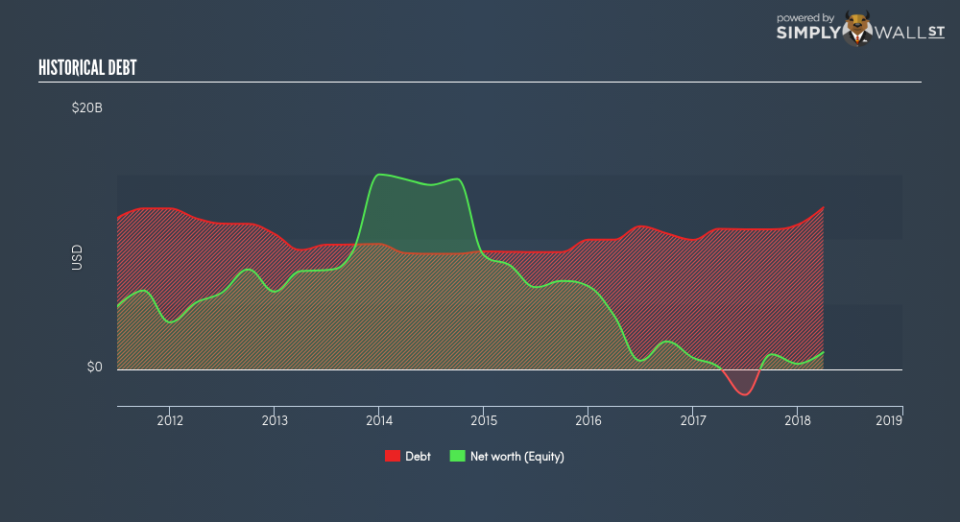Is The Boeing Company (NYSE:BA) A Financially Sound Company?

Investors seeking to preserve capital in a volatile environment might consider large-cap stocks such as The Boeing Company (NYSE:BA) a safer option. Doing business globally, large caps tend to have diversified revenue streams and attractive capital returns, making them desirable investments for risk-averse portfolios. However, the health of the financials determines whether the company continues to succeed. Today we will look at Boeing’s financial liquidity and debt levels, which are strong indicators for whether the company can weather economic downturns or fund strategic acquisitions for future growth. Note that this commentary is very high-level and solely focused on financial health, so I suggest you dig deeper yourself into BA here. View out our latest analysis for Boeing
How much cash does BA generate through its operations?
Over the past year, BA has ramped up its debt from US$9.95b to US$11.12b – this includes both the current and long-term debt. With this increase in debt, BA’s cash and short-term investments stands at US$9.99b for investing into the business. Additionally, BA has generated cash from operations of US$13.34b in the last twelve months, leading to an operating cash to total debt ratio of 120.03%, meaning that BA’s debt is appropriately covered by operating cash. This ratio can also be interpreted as a measure of efficiency as an alternative to return on assets. In BA’s case, it is able to generate 1.2x cash from its debt capital.
Does BA’s liquid assets cover its short-term commitments?
At the current liabilities level of US$56.27b liabilities, it appears that the company has been able to meet these obligations given the level of current assets of US$65.16b, with a current ratio of 1.16x. For Aerospace & Defense companies, this ratio is within a sensible range as there’s enough of a cash buffer without holding too capital in low return investments.
Does BA face the risk of succumbing to its debt-load?
Considering Boeing’s total debt outweighs its equity, the company is deemed highly levered. This isn’t uncommon for large companies because interest payments on debt are tax deductible, meaning debt can be a cheaper source of capital than equity. Consequently, larger-cap organisations tend to enjoy lower cost of capital as a result of easily attained financing, providing an advantage over smaller companies. No matter how high the company’s debt, if it can easily cover the interest payments, it’s considered to be efficient with its use of excess leverage. As a rule of thumb, a company should have earnings before interest and tax (EBIT) of at least three times the size of net interest. In BA’s case, the ratio of 60.26x suggests that interest is amply covered. It is considered a responsible and reassuring practice to maintain high interest coverage, which makes BA and other large-cap investments thought to be safe.
Next Steps:
BA’s high cash coverage means that, although its debt levels are high, the company is able to utilise its borrowings efficiently in order to generate cash flow. Since there is also no concerns around BA’s liquidity needs, this may be its optimal capital structure for the time being. I admit this is a fairly basic analysis for BA’s financial health. Other important fundamentals need to be considered alongside. I recommend you continue to research Boeing to get a better picture of the large-cap by looking at:
Future Outlook: What are well-informed industry analysts predicting for BA’s future growth? Take a look at our free research report of analyst consensus for BA’s outlook.
Valuation: What is BA worth today? Is the stock undervalued, even when its growth outlook is factored into its intrinsic value? The intrinsic value infographic in our free research report helps visualize whether BA is currently mispriced by the market.
Other High-Performing Stocks: Are there other stocks that provide better prospects with proven track records? Explore our free list of these great stocks here.
To help readers see pass the short term volatility of the financial market, we aim to bring you a long-term focused research analysis purely driven by fundamental data. Note that our analysis does not factor in the latest price sensitive company announcements.
The author is an independent contributor and at the time of publication had no position in the stocks mentioned.

 Yahoo Finance
Yahoo Finance 
